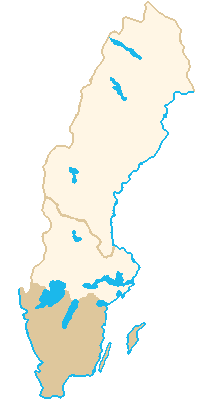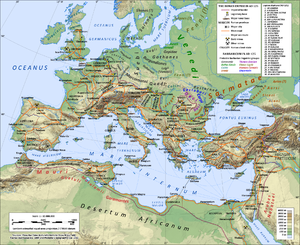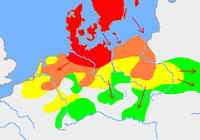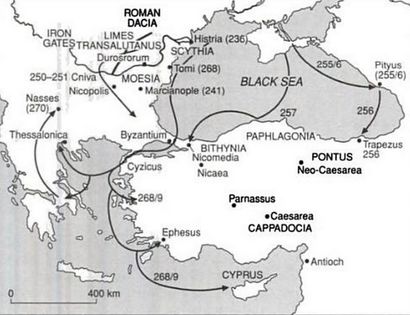قوط
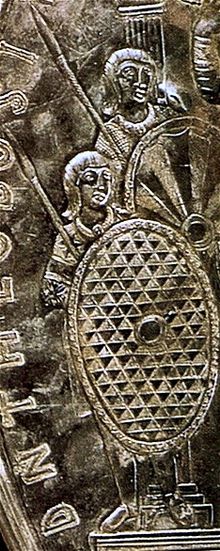
القوط Goths (بالقوطية: ![]()
![]()
![]()
![]()
![]()
![]() , گوتانس Gutans) قبائل جرمانية شرقية أرجح الآراء أنهم قدموا من إسكندنافيا إلى وسط وجنوب شرق القارة الأوروبية. قاموا بغزو الإمبراطورية الرومانية في القرن الثالث الميلادي عندما ساعد القوط وقبائل بربرية أخرى (همج) على إسقاط الإمبراطورية الرومانية الغربية. وكانوا من أوائل الشعوب الجرمانية التي اعتنقت النصرانية. ولكن يبقى الخلاف على أصولهم ومن أي بلاد قدموا قائما إلى اليوم. كان للقوط تأثيرا قويا في تاريخ أوروبا السياسي والثقافي. يقسم القوط غالبا إلى قوط شرقيين وقوط غربيين.
, گوتانس Gutans) قبائل جرمانية شرقية أرجح الآراء أنهم قدموا من إسكندنافيا إلى وسط وجنوب شرق القارة الأوروبية. قاموا بغزو الإمبراطورية الرومانية في القرن الثالث الميلادي عندما ساعد القوط وقبائل بربرية أخرى (همج) على إسقاط الإمبراطورية الرومانية الغربية. وكانوا من أوائل الشعوب الجرمانية التي اعتنقت النصرانية. ولكن يبقى الخلاف على أصولهم ومن أي بلاد قدموا قائما إلى اليوم. كان للقوط تأثيرا قويا في تاريخ أوروبا السياسي والثقافي. يقسم القوط غالبا إلى قوط شرقيين وقوط غربيين.
تكلم القوط اللغة القوطية، التي كانت واحدة من اللغات الجرمانية الشرقية المنقرضة.
أصل الاسم
In the Gothic language of Ostrogothic Italy they were called the Gut-þiuda, most commonly translated as "Gothic people", but only attested as dative singular Gut-þiudai;[1] another name, Gutans, is inferred from a genitive plural form gutani in the Pietroassa inscription.[2] In Old Norse they were known as the Gutar or Gotar, in Latin as the Gothi, and in Greek as the Γότθοι, Gótthoi.
الأصول
The exact origin of the ancient Goths remains unknown. Evidence of them before they interacted with the Romans is limited.[3] The traditional account of the Goths' early history depends on the Ostrogoth Jordanes' Getica written ح. 551 AD. Jordanes states that the earliest migrating Goths sailed from what is now Sweden to what is now Poland. If this is accurate, then they may have been the people responsible for the Wielbark archaeological complex.[بحاجة لمصدر] Modern academics have generally abandoned this theory. Today, the Wielbark culture is thought to have developed from earlier cultures in the same area.[4] Archaeological finds show close contacts between southern Sweden and the Baltic coastal area on the continent, and further towards the south-east, evidenced by pottery, house types and graves. Rather than a massive migration, similarities in the material cultures may be products of long-term regular contacts. However, the archaeological record could indicate that while his work is thought to be unreliable,[5] Jordanes' story was based on an oral tradition with some basis in fact.[4]
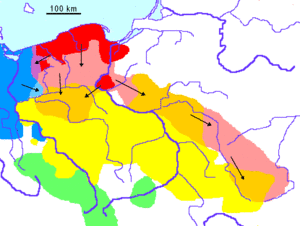
- red: Oksywie culture, then early Wielbark culture
- blue: Jastorf culture (light blue: expansion, purple: repressed)
- yellow: Przeworsk culture (orange: repressed)
- pink, orange, purple: توسع ثقافة ڤيلبارك (القرن الثاني الميلادي)
تاريخ
قبل التاريخ
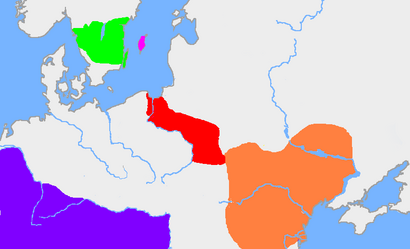 |
كل ما يعرف عن القوط قبل العام 551 م يؤخذ من مصدر وحيد وهو كتاب گتيكا للمؤرخ يوردانس.
استوطن القوط لفترة من الزمن في حوض نهر فيستولا ثم هاجروا إلى المناطق الجنوبية الشرقية من أوروبا وهناك تحاربوا مع أسلاف السلاف الذين كانوا يعيشون في تلك المناطق الموجودة بين بحر البلطيق والبحر الأسود. مكث القوط بعدها لمدة في ما كان يعرف باسم سكيذيا (اوكرانيا وأجزاء من روسيا البيضاء حاليا). انفصل القوط إلى قبيلتين في القرن الثالث الميلادي وتشكل ما يعرف بالقوط الشرقيين والقوط الغربيين.
أسس القوط الغربيين مملكة لهم في أراضي منطقة داتشيا بعد هزيمتهم المهلكة في معركة نايسس والتي دمرت الكثير من قواهم وأجبرتهم على الانسحاب للجانب الآخر من الدانوب. في المقابل قام القوط الشرقيين الذين لم يبرحوا مكانهم (بقوا في أوكرانيا وروسيا البيضاء) بتأسيس مملكة ذات نفوذ وقوة على شواطئ البحر الأسود تعرف باسم مملكة القوط الشرقيين.
وحد القوط تحت حكم ملك واحد في أوائل القرن السادس الميلادي على يد الملك القوي الشرقي ثيودوريك العظيم الذي أدخل مملكة القوط الغربيين تحت حكمه لفترة تزيد عن العقدين.
الأصل
من المحتمل أن يكون أصل القوط هو ما يعرف الآن بالسويد الجنوبية، ثم هاجروا إلى منطقة شمال البحر الأسود في القرن الثاني الميلادي. وفي القرن الثالث الميلادي أغاروا على حدود الإمبراطورية الرومانية الشمالية الشرقية. استوطن بعض القوط في داتشيا (جزء من رومانيا والمجر الآن) عام 272م. وفي القرن الرابع الميلادي انقسموا إلى قبيلتين. وصار القوط الذين استقروا في داتشيا يعرفون بالقوط الغربيين، بينما عُرف الذين استقروا في شمال البحر الأسود بالقوط الشرقيين.
تعرّض القوط الغربيون لتهديد القبائل الهونية من ناحية الشرق عام 376م. فاضطروا لعبور نهر الدانوب ولجأوا إلى مقاطعة بانونيا الرومانية، وقاموا بثورة واستطاعوا هزيمة الجيش الروماني عام 378م في أدريانوبل (تُعرف الآن أدرنة بتركيا) وقتلوا الإمبراطور الروماني فالنس. وبحلول عام 382م صار القوط الغربيون أول أُمّة بربرية مستقلة في الإمبراطورية الرومانية. قاموا بغزو إيطاليا بقيادة ملكهم ألارك في بداية القرن الخامس الميلادي ونهبوا روما عام 410م. انتقل خلفاء ألارك إلى بلاد الغال (فرنسا الآن) وأسبانيا. إلا إنهم هُزموا في بلاد الغال على يد قبائل الفرنجة (أو القبائل الجرمانية التي احتلت فرنسا) في أواخر القرن الخامس الميلادي، لكنهم استمروا في أسبانيا حتى عام 711م.
قامت القبائل الهونية بهزيمة القوط الشرقيين في السبعينيات من القرن الرابع الميلادي، ومن ثم عاش القوط الشرقيون تحت سيطرة الهون حتى موت أتيلا ملك الهون القوي عام 453م. وبعد ذلك انتقلوا إلى وسط أوروبا حيث انضم لهم ثيودوريك عام 471م. قام ثيودوريك بغزو إيطاليا عام 489م، واحتلها عام 493م، واستمر القوط الشرقيون فيها حتى هزمتهم الإمبراطورية البيزنطية (الرومان الشرقيون) عام 550م.
الهجرات والاتصال بروما
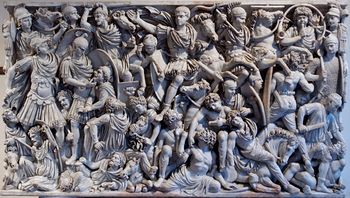
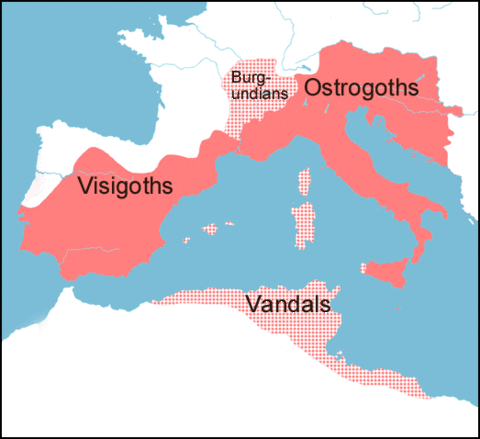
القوط الغربيون والشرقيون
الآثار
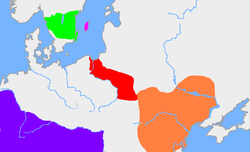
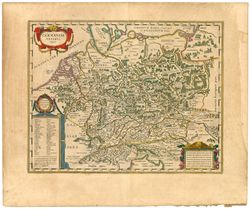
انظر أيضاً
نسلهم والشعوب ذات الصلة:
غيرهم:
الهامش
- ^ Hewitt, Winfred P. Lehmann ; with bibliography prepared under the direction of Helen-Jo J. (1986). A Gothic etymological dictionary. Leiden: E.J. Brill. pp. 163–164. ISBN 978-9004081765.
{{cite book}}: CS1 maint: multiple names: authors list (link) - ^ Braune, W; Heidermanns, F (2004). Gotische Grammatik. Tübingen: Niemeyer.
- ^ "Who Were the Ancient Goths?". Retrieved 2016-09-09.
- ^ أ ب Kaliff, Anders (2001). Gothic Connections. Contacts between eastern Scandinavia and the southern Baltic coast 1000 BC – 500 AD. Uppssala: OPIA. Retrieved 7 September 2016.
- ^ Kessler, P L. "Kingdoms of the Germanic Tribes - Goths / Ostrogoths". www.historyfiles.co.uk. Retrieved 2016-09-09.
مصادر خارجية
المصادر
- Andersson, Thorsten (1996). "Göter, goter, gutar". Namn och Bygd (in Swedish). Uppsala. 84: 5–21.
{{cite journal}}: CS1 maint: unrecognized language (link) - Bell-Fialkoff, Andrew, Editor (2000). The Role of Migration in the History of the Eurasian Steppe: Sedentary Civilization vs. "Barbarian" and Nomad. New York: St. Martin's Press. ISBN 0-312-21207-0.
{{cite book}}:|first=has generic name (help)CS1 maint: multiple names: authors list (link) - Bradley, Henry (1888). The Goths: from the Earliest Times to the End of the Gothic Dominion in Spain. London: T. Fisher Unwin. Downloadable Google Books.
- Dabrowski, J. (1989) Nordische Kreis un Kulturen Polnischer Gebiete. Die Bronzezeit im Ostseegebiet. Ein Rapport der Kgl. Schwedischen Akademie der Literatur Geschichte und Alter unt Altertumsforschung über das Julita-Symposium 1986. Ed Ambrosiani, B. Kungl. Vitterhets Historie och Antikvitets Akademien. Konferenser 22. Stockholm.
- Findeisen, Joerg-Peter: Schweden - Von den Anfaengen bis zur Gegenwart, Regensburg: Verlag Friedrich Pustet, 1998.
- Oxenstierna, Graf E.C. : Die Urheimat der Goten. Leipzig, Mannus-Buecherei 73, 1945 (later printed in 1948).
- Heather, Peter: The Goths (Blackwell, 1996)
- Hermodsson, Lars: Goterna - ett krigafolk och dess bibel, Stockholm, Atlantis, 1993.
- Kaliff, Anders: Gothic Connections. Contacts between eastern Scandinavia and the southern Baltic coast 1000 BC – 500 AD. Occasional Papers in Archaeology (OPIA) 26. Uppsala 2001.
- Mastrelli, Carlo Alberto in Volker Bierbauer et al., I Goti, Milan: Electa Lombardia, Elemond Editori Associati, 1994.
- Nordgren, I.: Goterkällan - om goterna i Norden och på kontinenten, Skara: Vaestergoetlands museums skriftserie nr 30, 2000.
- Nordgren, I.: The Well Spring of the Goths : About the Gothic peoples in the Nordic Countries and on the Continent (2004)
- Rodin, L. - Lindblom, V. - Klang, K.: Gudaträd och västgötska skottkungar - Sveriges bysantiska arv, Göteborg: Tre böcker, 1994.
- Schaetze der Ostgoten, Stuttgart: Theiss, 1995. Studia Gotica - Die eisenzeitlichen Verbindungen zwischen Schweden und Suedosteuropa - Vortraege beim Gotensymposion im Statens Historiska Museum, Stockholm 1970.
- Tacitus: Germania, (with introduction and commentary by J.B. Rives), Oxford: Clarendon Press, 1999.
- Wenskus, Reinhard: Stammesbildung und Verfassung. Das Werden der Frühmittelalterlichen Gentes (Köln 1961).
- Wolfram, Herwig (1988). History of the Goths: New and completely revised from the second German edition. Los Angeles: University of California Press. LC number D137.W6213 1987 940.1.
{{cite book}}: Unknown parameter|coauthors=ignored (|author=suggested) (help)
وصلات
- Jordanes (1997). The Origins and Deeds of the Goths (html). Calgary: J. Vanderspoel, Department of Greek, Latin and Ancient History, University of Calgary. Retrieved 2008-09-05.
{{cite book}}: Unknown parameter|coauthors=ignored (|author=suggested) (help) - Makiewicz, Tadeusz. "The Goths in Greater Poland" (html). The Council of Europe, EuRoPol Gaz S.A. Retrieved 2008-09-05.
- Skorupka, Tomasz (1997). "Jewellery of the Goths". Poznan Archaeological Museum. Retrieved 2008-09-16.
{{cite web}}: Unknown parameter|coauthors=ignored (|author=suggested) (help) - Hooker, Richard (1996). "The Germans" (htm). World Civilizations. Washington State University. Retrieved 2008-09-19.
- Kaliff, Anders (2001). "Gothic Connections:Abstract" (htm). Uppsala Universitet. Retrieved 2008-09-19.
- "The Savage Goths" - part of Terry Jones' Barbarians, June 2006.
- Articles with hatnote templates targeting a nonexistent page
- Articles with unsourced statements from November 2017
- CS1 errors: generic name
- CS1 errors: unsupported parameter
- Pages with empty portal template
- قوط
- شعوب جرمانية قديمة
- جماعات عرقية في أوروپا
- تاريخ الشعوب الجرمانية
- قدم متأخر
- فترة الهجرات
- رومانيا في العصور الوسطى المبكرة
- جرمانيون

